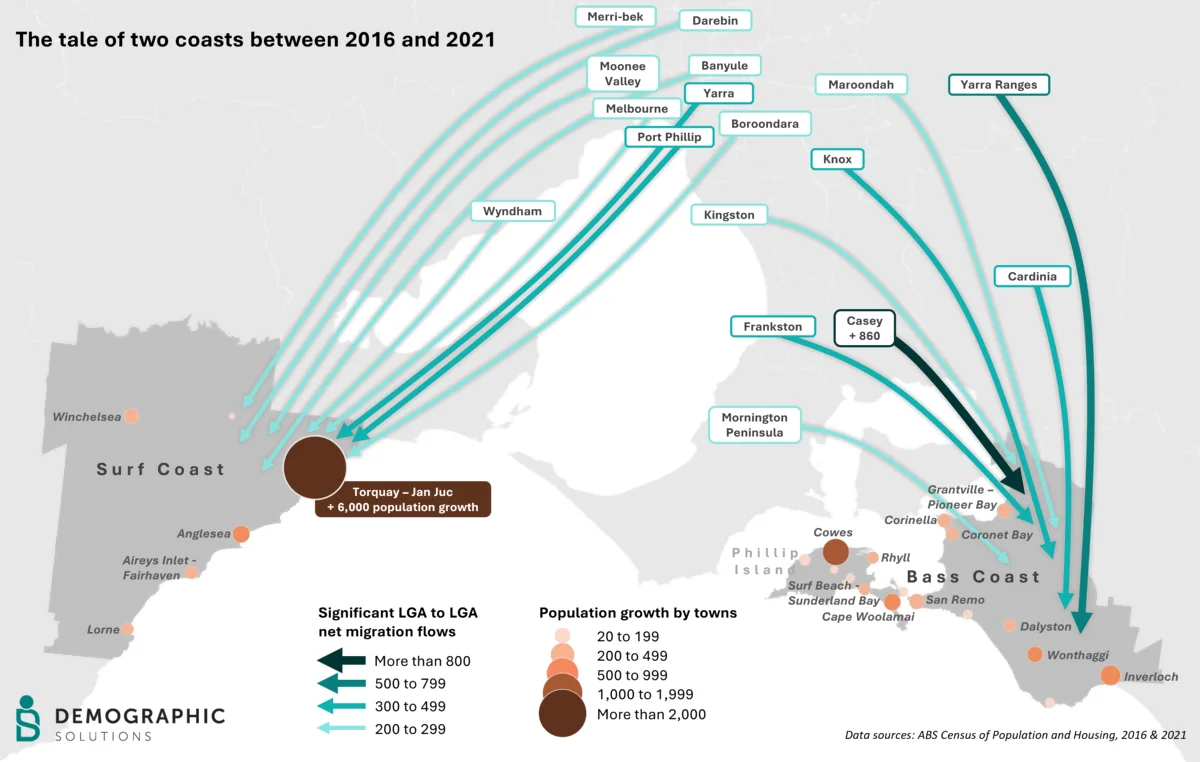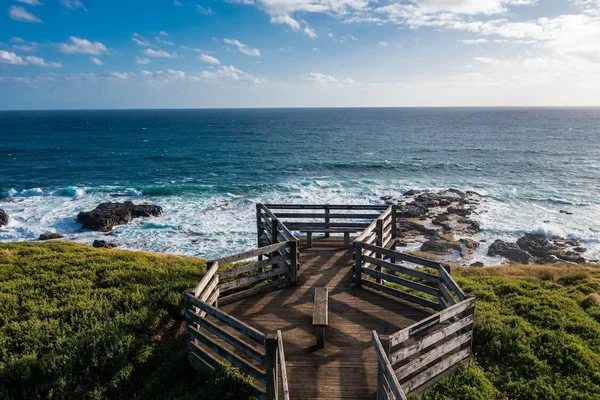Victoria has witnessed significant migration from Melbourne to regional towns during the last decade. The desire for a simpler, more affordable, and less stressful life allowed many Melburnians to pack their bags and ‘seek refuge’ in regional areas and coastal towns, altering the socioeconomic landscape and reshaping communities. With the power of retrospect, we take a look at the patterns of migration, the motivations behind them, and ask whether this trend is temporary or here to stay.
A changing market and pandemic spurred shift
This demographic shift was most prominent during the last inter-Censal period (2016-2021) and accelerated during the COVID-19 pandemic. The “Great Resignation” phenomenon during 2020 and 2021 saw a significant number of workers reflecting and re-evaluating career goals and life priorities. Many voluntarily left their jobs to retrain in other areas while some decided they wanted more work-life balance or sought positions that aligned better with their values.
The pandemic also accelerated the adoption of remote work and more flexible work arrangements as many businesses and services readapted. This shift allowed employees to seek jobs outside their immediate geographic area and pursue roles that offered more flexibility in terms of when and where they work. Labour shortages due to pandemic international border controls saw regional towns attract new workers from Melbourne in industries like agriculture, renewable energy, hospitality and tourism. Overall, this period marked a change in the spatial distribution of Victorians accelerated by the impacts of the pandemic.
However outside the influence of COVID-19, this period also saw rapid increases in the prices of residential property through Australia’s capital cities, leading Melburnians to look towards affordable options in regional Victoria. Coupled with more flexible work arrangements, housing opportunities in regional towns provided better “per square metre” value compared to Melbourne, without the daily commute and congestion. This was especially beneficial for Melbournians who continued their careers on “city” level salaries. The pandemic also allowed a spatial fleet-footedness, with many working from home and children attending school online, which is likely to have boosted growth in some of these coastal areas.
Impact of the pandemic on migration to the Regions
Since the pandemic restrictions have ended, the harsh realities of life have returned in many ways, with the economic pressures of higher interest rates, higher inflation, and to some degree, a return to the office
A look at the data shows that overall, there has been a net migration of people from Melbourne to regional Victoria between 2006 and 2021 at a broad SA4 level.
- The 2006-2011 and 2011-2016 periods were relatively similar with about a gain of 21,500 to 22,300 Melburnians to the regions during these periods.
- Between 2016 and 2021, there was nearly a net gain of 65,000 Melburnians packing their bags, with nearly 20,000 of them moving to the Geelong region (includes Geelong, Surf Coast and Golden Plains LGAs).
- Significant moves to the Latrobe-Gippsland region (includes Bass Coast, Latrobe, South Gippsland etc)
- North West (includes Mildura, Swan Hill, Ararat etc) bucked it’s historical trend of population loss and gained nearly 1,000 Melburnians.
Most interesting though is that a quarter of the net migration from Melbourne to the regions occurred between 2020 and 2021 – the approximate period of Covid-19. All the regions saw their greatest net gains during the 2020-2021 period with Geelong and Latrobe-Gippsland leading the way. North West and Shepparton saw well over a third of its growth from Melburnians during this 12 month period.
Which LGAs saw the most migration between 2016 and 2021?
The seaside “holiday house” … a romantic notion for many Australians, no doubt saw greater occupancy during the pandemic. Border closures and intermittent travel restrictions during various points of 2020 and 2021 meant those who had access to one had the opportunity of remote work whilst enjoying the offerings of coastal life.
However, these were not the only houses being consumed during pandemic. Even before all the craziness of travel restrictions and work-from-home orders, there were many coastal centres and towns that had new residential greenfield projects either in the planning pipeline or had just commenced during the low interest rate environment of 2016-2021. However, it wasn’t until the pandemic that this demand for new dwellings in the regions accelerated, attracting many from Melbourne and neighbouring LGAs looking for new housing opportunities.
As highlighted in our previous blog, “Population growth in Victoria: Stories from the 2021 Census”, both Surf Coast and Bass Coast (LGAs) ranked top 5 amongst the fastest growing LGAs in Victoria between 2016 and 2021. In fact, the population growth rates of these two coastal LGAs were also “on-par” with popular greenfield areas in Melbourne: Wyndham, Melton and Cardinia. As we pair this data beside the net migration gains from Melbourne, it’s reveals that about 69% of new residents in Bass Coast between 2016 and 2021 arrived from Melbourne. For Surf Coast during this period, about one in every second person arrived from Melbourne.
The tale of two coasts
Melburnians generally preferred either Surf Coast or Bass Coast depending on where they lived in 2016. Surf Coast gained from the inner parts of Melbourne, the middle north and the northwest with some notable numbers from the outer west, notably Wyndham. As proximity is an important consideration in migration, many people continued their movement outward, along sectoral lines away from Melbourne, maintaining their road and rail access along the Princes Highway Corridor. In addition, Geelong has become a significant economic hub and a catalyst for growth in the region. In contrast, Bass Coast attracted Melburnians from the middle and outer eastern and southern suburbs. The Bass Coast remains in close proximity to major employment hubs such as Dandenong and emerging employment centres, such as Pakenham.
Most of Surf Coast’s population growth was concentrated in Torquay-Jan Juc increasing by 6,056 persons between 2016 and 2021. This growth was driven by high rates of greenfield residential development in new estates such as The Dunes Estate and Quay2 Estate. Albeit much smaller in growth, Anglesea’s population increased by 25% or 650 persons during this period.
Population growth in Bass Coast was more dispersed throughout with about nearly 3,500 of the growth occurring on Phillip Island (approx. 42% of Shire growth). Cowes had the largest amount of growth, going from 4,944 in 2016 to 6,797 in 2021 (increase of 1,853 persons or 37%). Elsewhere on the Island, Cape Woolamai also saw a 37% increase going from 1,675 to 2,301 (+626 persons) during this period. On the mainland, Inverloch (+1,090 persons) and Wonthaggi Township (+ 879) experienced the most significant gains.

Despite the numerous advantages of migrating to regional towns, challenges do exist. The cost of housing in regional towns and centres has become more expensive for long-term residents and their families as they compete with “Melbourne” money. Infrastructure development must keep pace with population growth to ensure that every resident has equal access to essential health and education services. All this while preserving unique identities and environmental amenities has become a balancing act for planners, developers and policy makers alike.
So do they stay or go?
Are you or do you know someone who made the move from Melbourne to a regional town between 2016 and 2021? And are you or that person you know:
- Likely to stay in the town they moved to
- Considering a move back to Melbourne
- Have already returned to Melbourne after August 2021 (post Census ’21)
- Or currently live in Melbourne but most likely to move to a country town in the next few years.
As population forecasters, we’ve been having this conversation and wondering how permanent this demographic shift to the regional towns? Is it likely to continue as more and more people reframe and re-prioritise life and (remote) work balance? Do local governments have the capacity and support to increase services and improve infrastructure if this continues? What will “affordable” housing look like in these towns for long-term residents and their families? The timely alignment of the 2021 Census and the historical events of the pandemic allowed us an insight to people’s behaviours and we look forward to seeing what the 2026 Census will tell us.
Feel free to share this article or your thoughts in the comments section below. We are very interested in getting a better grasp on this great demographic shift. If you found this blog interesting, you can also follow our Linkedin page to stay updated with new releases.
For more COVID-19 related blogs, check out:

